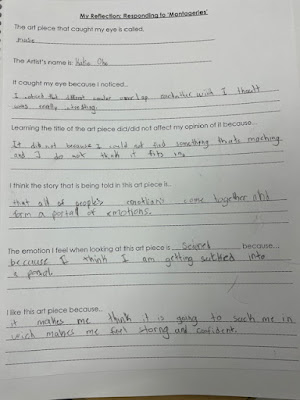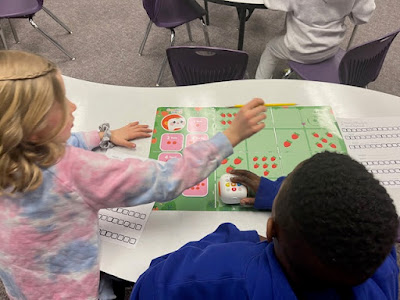Students start each math class with a warm up. When they come in from recess, they get started on answering question(s) right away using personal strategies that work best for them. Students then volunteer to come up and share their answers explaining what strategy(s) they used to solve the question or problem.
Students are continuing to work on problem solving in math. One of the most difficult parts of solving a word problem is understanding which operation will help them solve to find the answer. Students have been encouraged to use our math key word sheet as well as the “RICE” acronym:
Read the problem.
Identify the important information.
Compute the problem using the correct operation.
Explain your thinking by showing your work and writing a sentence.

Another strategy we have continued to use is non-permanent writing surfaces. We begin by using our popsicle sticks to create random groups of three. We use random groupings to ensure students have the opportunity to collaborate, share and learn alongside a variety of classroom peers.
Why Groups of Three?
This helps to ensure that all students in the group contribute. One student is the recorder and is responsible for writing down their partners’ thinking (strategies) using the white board marker. Students rotate roles and take on the “thinking” role and “recording” roles based on their comfort level with the word problem.
Why Vertical Non-Permanent Surfaces?
Students are often more willing to take risks for their learning and attempt problem solving using a non-permanent surface because if they make a mistake it can easily be erased. Research has shown that students who have the opportunity to stand, collaborate and work on Vertical Boards, students are more likely to engage in their learning and attempt higher level thinking problems.
How Do Students Answer Questions in a Thinking Classroom?
As students complete one problem, they raise their hand to get their work checked. In order to be given an extension problem or the next problem, students need to have the outlined success criteria completed.
Once groups have received a check mark, they are able to choose between different word problems to continue their thinking and learning. If a group has difficulty moving forward with a word problem, I will often ask them a question, give them a hint or re-read a section of the word problem to try to help them without explicitly showing them how to solve the problem.
Finally, we look at each other's work and/or use the Smartboard to go through the problem together as a class. We look at different strategies, ways to organize our work and see if there are more efficient ways to solve the problems.
Read the problem.
Identify the important information.
Compute the problem using the correct operation.
Explain your thinking by showing your work and writing a sentence.

Another strategy we have continued to use is non-permanent writing surfaces. We begin by using our popsicle sticks to create random groups of three. We use random groupings to ensure students have the opportunity to collaborate, share and learn alongside a variety of classroom peers.
Why Groups of Three?
This helps to ensure that all students in the group contribute. One student is the recorder and is responsible for writing down their partners’ thinking (strategies) using the white board marker. Students rotate roles and take on the “thinking” role and “recording” roles based on their comfort level with the word problem.
Why Vertical Non-Permanent Surfaces?
Students are often more willing to take risks for their learning and attempt problem solving using a non-permanent surface because if they make a mistake it can easily be erased. Research has shown that students who have the opportunity to stand, collaborate and work on Vertical Boards, students are more likely to engage in their learning and attempt higher level thinking problems.
How Do Students Answer Questions in a Thinking Classroom?
As students complete one problem, they raise their hand to get their work checked. In order to be given an extension problem or the next problem, students need to have the outlined success criteria completed.
Once groups have received a check mark, they are able to choose between different word problems to continue their thinking and learning. If a group has difficulty moving forward with a word problem, I will often ask them a question, give them a hint or re-read a section of the word problem to try to help them without explicitly showing them how to solve the problem.
Finally, we look at each other's work and/or use the Smartboard to go through the problem together as a class. We look at different strategies, ways to organize our work and see if there are more efficient ways to solve the problems.
As we are working towards mastering our multiplication facts we have also been playing lots of math games such as: Multiplication Four In a Row, Salut, Array Tray, War and Kaboom!
Mathematics Learning Outcome:
Students analyze and apply strategies for multiplication and division within 100.
Student Learning Objectives:
- I can recognize interpretations of multiplication and division in various contexts.
- I can compose a product using equal groups of objects.
- I can relate multiplication to repeated addition.
- I can relate multiplication to skip counting.






















































